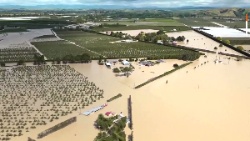Government-owned Kiwirail is supposed to be presiding over the New Zealand Main Trunk (Railway) Line, from Auckland to Invercargill. As such it runs a ferry service (The Interislander) between New Zealand's North and South Islands.
We are being told by Kiwirail (and see today's report on Radio NZ) that the only rail-enabled roll-on roll-off ferry – the Aratere – will cease operations in August this year, five years before its putative successor ferries will commence operations.
At the same time, rail is being revitalised in the South Island, with the Hillside workshops redevelopment. (And see the following on Scoop last Friday: New Hillside Workshops Officially Opened and Rail Workers Celebrate Hillside Workshops Rebirth.) How can this be: simultaneous expansion and contraction of New Zealand's trunk railway under the governance of the same government?
There is a simple conceptual solution, which covers both the short run and the long-run.
Kiwirail could relocate the Interislander's South Island terminus to Lyttelton, the rail-accessible port of Christchurch. Indeed this should have become policy after the dramatic 2016 Kaikoura earthquake which destroyed both railway and highway around Kaikoura, halfway between Wellington and Christchurch; both road and rail main trunk. Not only is the present route precarious, but also it is so much 'greener' for both road and rail traffic between the North Island and the southern 85% of the South Island (by population) to travel by sea between Wellington and Christchurch. That is, the bulk of interisland vehicle travel undertaken directly by sea is more sustainable than a journey by sea between Wellington and Picton followed by a long 340km Picton to Christchurch land journey.
The suggested solution is that The Interislander should operate out of Lyttelton from about 2030, leaving Bluebridge to service the Wellington Picton route. If that were to happen, then the Aratere could stay in service until 2030; because the new facilities suited to the new ships – at least the South Island facilities – would not have to be on the same site as Picton's present rail-ship facilities.
Last year I wrote to MPs from all five parties, before it was too late to cancel the shipping order for the cancelled iRex project, including the Labour MP for Lyttelton. Only the Green Party bothered to reply to me. And even they were unenthusiastic about the idea of the Interislander shifting to Lyttelton; their lack of interest came across as more a matter of political priority than as an argument about economics or sustainability.
Maybe I am stupid, and I simply cannot see the obvious reasons why a shift back to Lyttelton cannot happen. But I really think we should have a national conversation about the restoration of ferry services between Wellington and Lyttelton; and with the current consciousness about the future of rail being a very important stimulus to that conversation.
After all, for over 100 years, before 1960, Wellington to Lyttelton was the essential 'main trunk' link between the two islands. The change-around happened around 1960 because the previous Wellington to Picton service had become so run-down that something had to be done about it. And that there just happened to be a relatively new railhead at Picton. After 1960, the Lyttelton service was doomed to fail when it became a one-ship service in 1968, after the tragic demise of the then state-of-the-art Wahine.
Why don't we have national conversations anymore? Everything seems to happen as a fait accompli, narratives driven by unimaginative back-office accountants with short time horizons. And mainstream academics and media simply accept this under-democratic state of affairs.
We are still suffering from the infrastructure backlog that escalated in the early 1990s when Finance Minister Ruth Richardson forced many of New Zealand's unemployed and underemployed to emigrate, especially to Australia; all in the name of 'fiscal responsibility'. Some of those people who left for Australia just as its banking crisis was unfolding – especially their children – are drifting back to New Zealand in the 2010s and 2020s as '501' deportees (see Product of Australia, Stuff December 2019, and noting in a chart that more than half of the 501s deported to New Zealand from 2015 to 2019 were aged 26 to 40).
Those young (mainly) men could have been building New Zealand; instead, too many became criminals in Australia. And the New Zealand economy regressed for the best part of ten years (from 1985), while the rest of the world was progressing. That period is the source of the now-entrenched Australia New Zealand differential in living standards.
Keith Rankin (keith at rankin dot nz), trained as an economic historian, is a retired lecturer in Economics and Statistics. He lives in Auckland, New Zealand.



 Binoy Kampmark: Ominous Plans - Making Concentration Camp Gaza
Binoy Kampmark: Ominous Plans - Making Concentration Camp Gaza Ramzy Baroud: Fragmenting A Nation - Israel's Enduring Pursuit Of Palestinian Disunity
Ramzy Baroud: Fragmenting A Nation - Israel's Enduring Pursuit Of Palestinian Disunity Keith Rankin: Letter From Westphalia, Germany; 6 June 1933
Keith Rankin: Letter From Westphalia, Germany; 6 June 1933 Peter Dunne: Dunne's Weekly - Little Needs To Up His Game, Otherwise Wellington's Council Circus Will Continue
Peter Dunne: Dunne's Weekly - Little Needs To Up His Game, Otherwise Wellington's Council Circus Will Continue Gordon Campbell: On Ducking The Costs Of Climate Change
Gordon Campbell: On Ducking The Costs Of Climate Change Eugene Doyle: Vive La Resistance! The Heroes Who Oppose Genocide
Eugene Doyle: Vive La Resistance! The Heroes Who Oppose Genocide